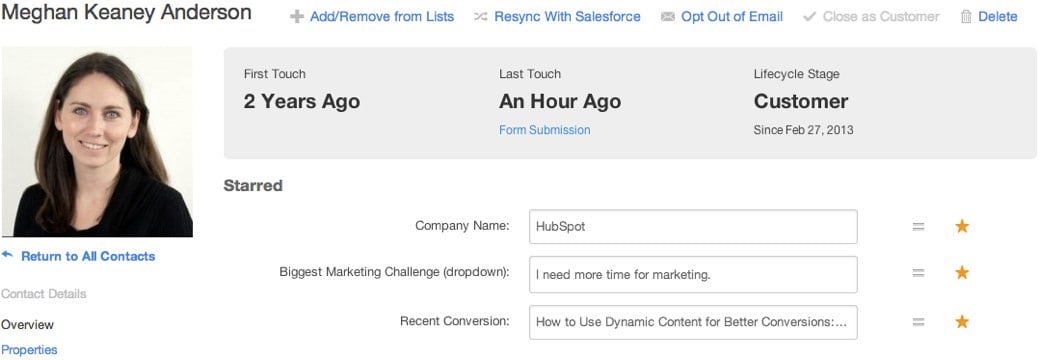How to Use Dynamic Content for "Smarter" Marketing
by Meghan Keaney Anderson

September 6, 2013 at 11:00 AM
116
inShare
inShare
 If you've been following inbound marketing for a while, you've probably heard of the term 'smart content' before. It's one of those terms lots of people use and assume that most everyone knows what it is. But not all of us are in the know -- lots of people are searching about it every day. So we wanted to break it down once and for all. What is smart content and how will it impact your marketing? Let's dive in.
If you've been following inbound marketing for a while, you've probably heard of the term 'smart content' before. It's one of those terms lots of people use and assume that most everyone knows what it is. But not all of us are in the know -- lots of people are searching about it every day. So we wanted to break it down once and for all. What is smart content and how will it impact your marketing? Let's dive in.What Is Smart Content?
First things first: What does 'smart content' even mean? In simple terms, smart content is content that adapts to the characteristics of the person consuming it. The goal of smart content is to provide a more relevant experience than could otherwise be achieved through static content.
To fully understand smart content and why it's growing as a marketing term, it helps to step back and take a look at a larger shift happening across many of the popular products and services we use today.
- Nest: Nest is a "smart" thermostat that adapts to the patterns of behavior its users exhibit. For example, if you go away every weekend and turn your thermostat down, Nest will learn over time that that's a typical behavior and eventually adapt to do it for you.
- Rdio, Spotify, or Pandora: Each of these music services learns your interests over time and adapts to build you a personalized station.
- Waze: Recently bought by Google, Waze takes static maps and infuses them with real-time context from other vehicles. It enables the passenger in your car to influence the recommended routes by reporting accidents, traffic, and even good rest stops, and then transmits that feedback to all other drivers on the road. Basically, your map adapts as the driving situation unfolds.
- Netflix: Netflix takes your viewing behavior and adapts to elevate similar genres and content. Each Netflix user has a customized list of recommendations.
The commonality among all of these products is the product or service's ability to recognize data points and adjust to better fit the person using them. This personalization turns everyday static objects into "smart" objects. Marketing has started to follow a similar trend.
Smart content in marketing began with the personalization of email campaigns. Using data from a contact database, marketers could segment their mailing lists based on a recipient's characteristic. That targeting proves to be quite successful: According to Aberdeen group,personalized emails improve click-through rates by 14% and conversion rates by 10%.
Moving to personalization across channels, particularly on websites, is an important next step in meeting customers' expectations and behavior. A 2013 study from Harris Interactive and Janrain found that nearly three-fourths (74%) of online consumers get frustrated with websites when content they see has nothing to do with their interests.
Smart content in marketing takes the lessons from marketers' early experiences customizing email sends and applies it to content throughout the marketing toolset. Just as each recipient gets targeted emails with marketing automation, each website visitor sees customized webpages with smart content.
How Smart Content Works
For the techie inside of you, let's break this down and talk about what actually happens to make smart content work.
1) The Marketing Database
Smart content starts with information from a marketing database or customer relationship management (CRM) system. That database is a repository for any interaction you've had with a lead or customer. When individuals first opt-in to your marketing by completing a form or making a purchase, the database can begin to store information about the content they've consumed or items they've purchased. It can also store demographic or contact information they provide through form submissions. Once your database creates a profile on someone, you can put that information to use to make his or her experience more relevant.

2) Smart Rules and a Smart Content Generator
Next, you need smart rules to set the criteria for personalization and a smart content generator to pull up different pieces of content based on those smart rules. For example, a smart rule could be, "if the database says someone has already provided you with his or her company name, show them this piece of content." Smart content generators can then generate any type of content you'd like based on that rule: images, videos, text, call-to-action buttons etc. In the example below, we're creating different content for customers than for everyone else. Anyone who meets the criteria of being a customer will get a tailored message.

3) An Integrated Platform
Having all of your marketing tools integrated into one platform with one shared contact database can help make sure that personalization rules extend throughout the platform and don't lead to inconsistent experiences from channel to channel.
Smart Content Pitfalls To Avoid
Now that we've covered how it technically works, let's talk about a few strategy errors that could cause it to backfire in your marketing.
Personalization That's Not Permission-Based
In the Harris Interactive/Janrain survey mentioned above, nearly 60% of respondents reported that they would be happy to give their personal information on a website if the data they provided would be used responsibly and for their own benefit. That decision of providing information should sit squarely with the website visitor. While things like geographic customization are possible by using an anonymous IP address, efforts to personalize prior to a form conversion or other opt-in by the user can be both error-prone and arguably a violation of the tenets ofpermission-based marketing.
Data Inaccuracy
Smart content relies on getting your data right. So you have to have a good deal of trust in you data and a way to easily fix inaccurate information. When we launched our new homepage last month, we took a bit of a risk. For a subset of our audience who we know well, we used smart content to add their name to the homepage when they view it. The result looks like this:

However, even with trustworthy data, you run the risk of having a few names or data points wrong. So, when we launched the homepage, we also opened up a way for people to update their information if their names didn't appear correctly.
Over-Personalization
As it develops, smart content will enable marketers to personalize in fascinating new ways. However, beneath all of the functionality, you should remember why you're personalizing to begin with. Using smart content for the sake of it, without thinking about how it should aid or guide the viewer, can lead to personalization that is neither effective nor warranted.
Building a Smart(er) Content Strategy
So how do you develop a smart content strategy that works? Smart content is incredibly effective when marketers use it to serve the needs of the customer. Every smart content or personalization strategy should start and end with one question: How does this make for a better end-experience? Before you begin personalizing your website with smart content, make a list of things that would be useful for your leads and customers.
What's useful?
- Don't show me content I've already read or downloaded.
- Elevate content that fits my industry, role, or persona.
- Don't pitch me if I'm already a customer.
- Make some data from my profile easy to find -- like my account manager or my purchase history.
Do that and the results will follow. Over the last year, HubSpot users have been experimenting with using smart CTAs in their marketing. Smart CTAs are a form of smart content that shows different call to action buttons based on the characteristics of the person looking at them. The goal is to match the call-to-action on a website, blog, or landing page with the need that is most likely to be relevant to the person considering it. After a year of use, we looked at the data for more 93,000 calls-to-action created using HubSpot, the total of which resulted in hundreds of millions of views and found that calls-to-action targeted to the user had a 42% higher viewed to submission rate than calls-to-action that were the same for all visitors.
Since we just added more smart content options, we're looking forward to seeing the ways that HubSpot users personalize their content this year. We'd love some starter ideas. What would be a helpful use of smart content from your perspective?